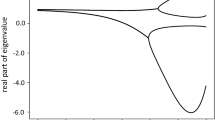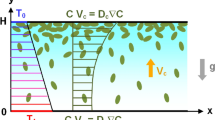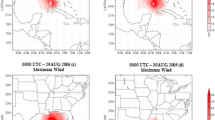Abstract
The 3-D spiral structure resulting from the balance between the pressure gradient force, Coriolis force, and viscous force is a common atmospheric motion pattern. If the nonlinear advective terms are considered, this typical pattern can be bifurcated. It is shown that the surface low pressure with convergent cyclonic vorticity and surface high pressure with divergent anticyclonic vorticity are all stable under certain conditions. The anomalous structure with convergent anticyclonic vorticity is always unstable. But the anomalous weak high pressure structure with convergent cyclonic vorticity can exist, and this denotes the cyclone’s dying out.
Similar content being viewed by others
References
Andrews, D. G., and J. R. Holton, 1987:Middle Atmospheric Dynamics, Academic Press, New York, 489pp.
Chandrasekhar, S., 1961:Hydrodynamic and Hydromagnetic Stability. Oxford University Press, New York, 613pp.
Charney, J. G., 1948: On the scale of atmospheric motions.Geophys. Publ.,17, 1–17.
Emmanuel, K. A., 1994:Atmospheric Convection, Oxford University Press, New York, 580pp.
Haltiner, G. L., and F. L. Martin, 1957:Dynamical and Physical Meteorology. McGraw-Hill, New York, 470pp.
Holton, J. R., 1972:An Introduction to Dynamic Meteorology, Academic Press, New York, 319pp.
Houghton, H. G., 1985:Physical Meteorology, MIT, MA, Cambridge, 442pp.
Kubicek, M., and M. Marek, 1983:Computational Methods in Bifurcation Theory and Dissipative Structure, Springer-Verlag, Berlin, 276pp.
Kurihara, Y., 1982: Influence of environmental condition on the genesis of tropic storms.Intense Atmospheric Vortices, L. Bengtssoon and J. Lighthill, Eds., Springer-Verlag, Berlin, 71–79.
Kuznetsov, Y. A., 1996:Elements of Applied Bifurcation Theory. Springer-Verlag, Berlin, 551pp.
Lilly, D. K., 1982: The development and maintenance of rotation in convective storms.Intense Atmospheric Vortices, L. Bengtssoon and J. Lighthill, Eds., Springer-Verlag, Berlin, 149–160.
Liu Shida, Liu Shikuo, Fu Zuntao, Xin Guojun, and Liang Fuming, 2003: From 2-D geostrophic wind to 3-D vortex motions.Chinese Journal of Geophysics,46(4), 649–656.
Liu Shida, Xin Guojun, Liu Shikuo, and Liang Fuming, 2000: The 3-D spiral structure pattern in the atmosphere.Adv. Atmos. Sci.,17(4), 519–525.
Panofsky, H. A., and J. A. Dutton, 1984:Atmospheric Turbulence. John Wiley & Sons, New York, 397pp.
Sullivan, R. D., 1959: A two-cell vortex solution of the Navier-Stokes equations.J. Aero/space Sci.,26, 767–768.
Zeng Qingcun, 1979:Mathematical and Physical Basis of Numerical Weather Forecasting (I). Science Press, Beijing, 543pp.
Author information
Authors and Affiliations
Rights and permissions
About this article
Cite this article
Liu, S., Liu, S., Fu, Z. et al. The structure and bifurcation of atmospheric motions. Adv. Atmos. Sci. 21, 557–561 (2004). https://doi.org/10.1007/BF02915723
Received:
Revised:
Issue Date:
DOI: https://doi.org/10.1007/BF02915723




